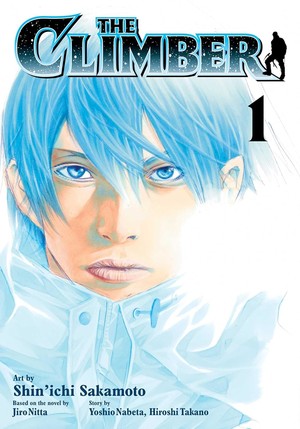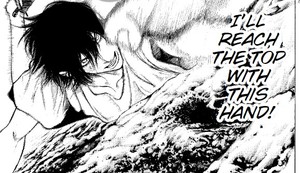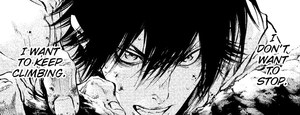The Spring 2025 Manga Guide
The Climber
What's It About?

Transfer student Buntaro Mori starts his first day at his new school already on the administration's radar. He's withdrawn and sullen, and the teachers are just waiting for him to explode. When his annoying classmate Miyamoto promises to leave him alone forever if he climbs to the top of the school, Mori eagerly takes up the challenge and shocks everyone when he makes it all the way to the roof. Flushed with the victory of his first successful climb, Mori can't resist the lure of the local peak, despite warnings from more experienced climbers about the risks of climbing alone. But Mori doesn't care. A little danger is nothing in the face of his new obsession.
The Climber has art by Shin'ichi Sakamoto and a story by Yoshio Nabeta and Hiroshi Takano, based on a novel by Jiro Natta with English translation by John Werry and lettering by Joanna Estep. Published by Viz Media (April 15, 2025). Rated T+.
Is It Worth Reading?
Christopher Farris
Rating:

Sakamoto's visibly developing approach thus climbs onto what is otherwise a rock-solid sports manga framework. There is a struggling club to bring into the business, mentor figures who think the lead character may be "the one," and a curmudgeonly rival. These are strong, smart usages of these tropes, with coach Ohnishi being the generally cool, encouraging type you like seeing lead kids like this. Rival Miyamoto at first comes off brusque, but reveals himself as more layered and a strong foil to Mori; where Mori is solo-centered and interior, Miyamoto is exceedingly focused on others. It leads him to be the perhaps surprising complementary training partner Mori needs. It's to the point that it's almost laughable that the writing tries to play up a potential romance between Miyamoto and club manager girl Shirai. Sakamoto's portrayal of the bromance between the boys resonates way harder. Shocker, I know.
If Sakamoto's drawing of these characters is still more standardized for manga than he'd come to be known for, then the art itself is still immensely strong. The detailed climbing faces, both natural and artificial, are pockmarked with realistic renderings of the grips and holds participants have to parse. When someone like Mori starts up one of them, the pages shift into vertigo-inducing spreads embracing those heights. These are details and indulgences that betray Sakamoto's fascination and love for the material entirely through his art. It lets readers feel how far he was coming in his craft even at this stage of reinventing it, and lets them see the path he would take to scaling the incredible heights he's reached today.

Rating:
Shin'ichi Sakamoto, of Innocent and #DRCL midnight children fame, has a distinct style combining gorgeously macabre art, deeply flawed (or downright awful) characters, and a general disdain for societal norms and authority figures. I'm not sure I can say I enjoy Sakamoto's works, but I find them dramatically compelling and analytically interesting.
The Climber, first published in 2007, shows flashes of Sakamoto's later style. Exaggerated, grotesque muscles stretch and strain across pages, gritty mountains loom menacingly, and a monstrous climbing wall resembles a many-eyed eldritch horror. The art reflects the genre: a mid-00s “gritty” sports series full of jacked high school boys snarling at each other. It flows well, and the climbing sequences shriek with tension (and occasional awe), but it's not yet the visual feast of later Sakamoto works.
As a narrative, The Climber seems interested in exploring the idea that “manly strength” means seeing everyone as an enemy or victim, doing everything alone, and not caring who gets hurt in the process. I get the sense the series wants to respect loners and risk-taskers without glorifying destruction (of oneself or others), but it's a wobbly tightrope, and it's not always clear if this first volume is critiquing or condoning the toxic behaviors it depicts.
Due to past trauma, protagonist Buntaro Mori is cynical and antisocial, and it's easy to see why: the teen boys around him are balls of arrogant hostility, and most of the adult men are dismissive at best and manipulative at worst. (The One Girl is a romantic object and damsel-in-distress, so she barely counts as a character.)
Mori's coach, Ohnishi, is the one consistent spot of hope. Despite slapping Mori in his first scene (not a great first impression, Coach!), he's the only person who tries to help and understand Mori. He accepts Mori's dangerous climbing goals while also encouraging him to value his life and relationships with others. Mori and his chief rival, Miyamoto, also develop a tentative friendship that keeps the story from becoming too misanthropic (although even then, they're using each other as tools to improve their climbing skills, so they still have a ways to go).
As all that may suggest, this is not a particularly likable cast or fun read—intentionally so, I'd argue. It is intriguing as a drama and a sports series, especially in the way it depicts mountain climbing as horror and wonder. Mori's few moments of peace occur when he's reached a summit, and Sakamoto's sweeping vistas depict a striking beauty and sense of freedom that contrasts against the grime and claustrophobia of much of the story.
I prefer my sports series with more optimism and humor (and better treatment of female characters), and 17 volumes is a big commitment, so I'm not sure I'll ever return to this one. Still, I can acknowledge there's potential here and would be curious to hear from others how the story's exploration of masculinity shakes out.
discuss this in the forum (28 posts) |
back to The Spring 2025 Manga Guide
Seasonal homepage / archives